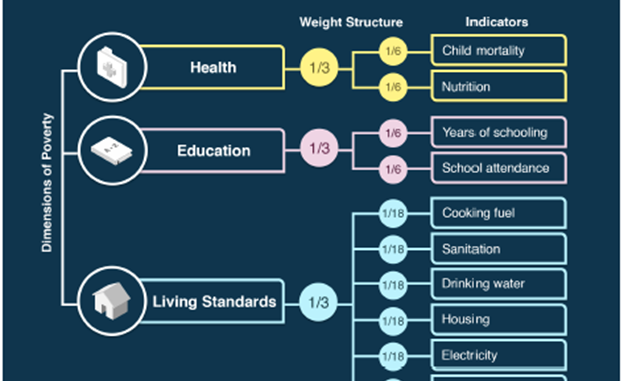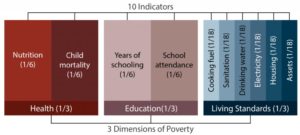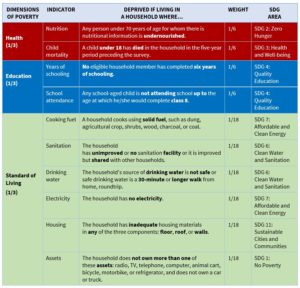
Table of Contents
Introduction:
- Multidimensional Poverty Index (MPI) is an international measure of acute multidimensional poverty covering over 100 developing countries.
- Multidimensional Poverty Index (MPI) is an index designed to measure acute poverty, understood as a person’s inability to meet minimum internationally agreed standards.
- MPI complements traditional monetary poverty measures by capturing the acute deprivations in health, education, and living standards that a person faces simultaneously.
- Multidimensional Poverty Index looks into more than just income or consumption, the traditional measures of poverty.
- In other words, MPI measure those experiencing multiple deprivations. For example, people who are undernourished, and do not have access to electricity or cooking fuel.
- Fundamentally, MPI reflects deprivations in very basic services and core human functioning for people across 104 countries.
- Multiple Poverty Index provides an alternative lens through which poverty may be viewed and understood through dimensions, indicators, and deprivation criteria.
- MPI is composed of 3 dimensions made up of 10 indicators (mentioned below)
- Among the 10 indicators, two are for health, two are for education and six indicators are for living standards.
- The indicators of MPI are closely linked to the Sustainable Development Goals (SDGs).
Dimensions and Indicators of Multidimensional Poverty Index:

There are 3 dimensions and 10 indicators used while measuring MPI. They are:
3 Dimensions of MPI:
- Health
- Education
- Standard of living
10 indicators (health-2, education-2, standard of living-6) of MPI:
1. Health (each indicator weighted equally at 1/6)
- Child mortality
- Nutrition
2. Education (each indicator weighted equally at 1/6)
- Years of schooling
- Child school attendance
3. Standard of living (each of the six indicators weighted equally at 1/18)
- Cooking fuel
- Sanitation
- Drinking water
- Electricity
- Housing
- Assets
Dimension, Indicators, Calculation of Deprivation and Weight:

- The MPI assesses poverty at the individual level.
- If a person is deprived in a third or more of ten (weighted) indicators, the global MPI identifies them as ‘MPI poor’.
- Intensity of a person’s poverty is also measured through the percentage of deprivations they are experiencing.
Range of Multidimensional Poverty Index:
- Multidimensional Poverty Index ranges from 0 to 1
- Higher number signifies greater poverty and vice versa.
Calculation of Multidimensional Poverty Index
MPI is the product of Incidence (H) and Intensity (A).
MPI= Incidence of poverty (H) * Intensity (A) of poverty
where,
- Incidence of poverty (H): is proportion of people identified as poor on the basis of the multiple deprivations they experience. ‘H’ denotes headcount ratio.
- Intensity of poverty (A): is how poor people are i.e., average proportion of (weighted) deprivations poor people experience. A denotes average deprivation share.
Example to Understand the ‘Incidence (H)’ and ‘Intensity (A)’ of Poverty:
- Imagine two countries: in both, 60% of people are poor. This 60% is the incidence of poverty in both the countries. Based on this incidence, the two countries are equally poor.
- Now, imagine that in one of the two countries, poor people are deprived – on average – in one-third of the dimensions, whereas in the other country, the poor are deprived – on average – in two-thirds of the dimensions.
- By combining the two pieces of information (i.e., the intensity of deprivations and the proportion of poor people), we can see that these two countries are not equally poor.
- Moreover, the second country is poorer than the first because the intensity of poverty is higher among the poor.
Advantages of Multidimensional Poverty Index (MPI):
- Helps to create comprehensive picture: MPI depicts who is poor and how they are poor. So, it can be used to create a holistic picture of people living in poverty.
- Highly comparative and replicable: MPI allows for comparison between countries or regions. It also allows within country comparison among different groups, urban and rural areas etc.
- Flexibility, Choice and Identifications: MPI can be adopted to different context with different unit of analysis whether developed or undeveloped countries. Transparency is maintained which helps in the clear identification of who is poor and communications is easy. As increase in the number of dimensions, measurement will be able to focus more acutely on poorest of poor.
- Effectiveness: The indicators used here have immediate practical applications and can be used to target poorest of poor more effectively.
- Prioritizing: MPI prioritizes work at both system level and the level of individuals/families
- Working Levels: MPI makes it possible to work on three levels; individual, agency and community. It also ensures implementation of policies through engagement of partners at various levels.
- Comparison: MPI provides basis to compare each individual’s achievement against the respective dimensions specific cut offs.
- Calculation: Well- being of different groups in the population can be calculated from it. For example; people from certain ethnic groups, regions, gender.
- Simplification: The measurements can be broken down into dimensions to reveal what dimensions contribute to the most dimensional poverty.
Limitations of Multidimensional Poverty Index (MPI):
- Poverty is a complex issue and depends on lot of factors; it is difficult or impossible to address all elements.
- Gathering of data for multidimensional indicators can be challenging.
- Due to large numbers of indicators, it can become overwhelming to deal and to make proper assessment leading to ineffective implementation.
- Intra-household inequality and inequality amongst the poor is not captured.
- Which and how many dimensions are relevant and should be considered or privileged are difficult to quote.
Human Development Index (HDI) Vs Multidimensional Poverty Index (MPI)
| Human development Index (HDI) | Multidimensional poverty Index (MPI) |
| HDI uses four indicators to measure its three dimensions; income, education, and health | MPI shares with the HDI in terms of
dimensions but goes further by incorporating 10 indicators |
| The calculation of the HDI relies on the geometric mean, which shows effect of a change in one dimension to be the same for a proportionate change in any of the other dimensions | The MPI is calculated using a threshold count approach where, an individual is considered poor if the number of her deprivations total to at least a third of the measured items. |
| It shows how close a country is in achieving human development. | It shows how far a country is from achieving human development. |
| HDI reports values that range between 0 and 1. The closer a country is to 1, the higher is the level of human development. | MPI, also ranges values between 0 and 1, but it is about the level of deprivation. In this case, the closer a country is to 1, the higher is the lack of human development. |
References and For More Information:
https://ophi.org.uk/ophi-mpi-methodological-note-49/
https://www.ophi.org.uk/wp-content/uploads/OPHI_MPI_MN_49_2020.pdf
http://hdr.undp.org/sites/default/files/mpi_trainingmaterial_mcc_mk_clean_june_2015.pdf
https://www.ophi.org.uk/wp-content/uploads/MPI-Primer.pdf
https://www.ophi.org.uk/wp-content/uploads/OPHI-wp38_with_note.pdf
https://mpra.ub.uni-muenchen.de/108501/1/MPRA_paper_108501.pdf